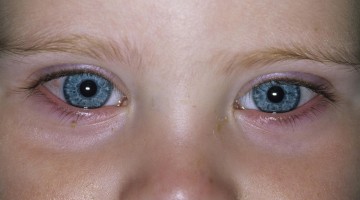Eye infections can arise in different parts of just one eye or both the eyes. Learn about some of the most common eye infections and their treatments in this article.
Conjunctivitis
Conjunctivitis is a widespread eye disorder that causes the conjunctiva (the thin layer of tissue that covers the front of the eye) to get inflamed resulting in redness and swelling of your eyes.
Treatment:
The treatment for conjunctivitis is cause-specific.
- Bacterial conjunctivitis:It can be treated with antibiotics, available in the form of ointments, eye drops, or pills. You can apply eye drops or ointments to the inside of the eyelid three to four times a day for duration of five to seven days. You may also need to administer pills for several days. The infection should recover within a week. Follow your doctor’s instructions.
- Viral conjunctivitis: Viral conjunctivitis can be highly contagious and usually goes away on it’s own, just like common cold. Keep away from others and wash your hands often. If you wear contact lenses, you must discard contacts worn while you have conjunctivitis and put on glasses. Avoid makeup and throw away the makeup you used while you have pink eye. You need to see your doctor immediately, if you develop unclear vision with pinkeye as some viruses leave scar on the cornea.
- Irritants:You may rinse your eyes well with water for five minutes. Your eyes should begin to get better within four hours. If acid or alkaline material such as bleach has caused you conjunctivitis, instantly rinse the eyes with lots of water and call your doctor without delay.
- Allergies: Conjunctivitis caused by an allergen should improve once the allergy is treated and the allergen is removed. Consult your doctor for a treatment plan.
Dry eyes
Dry eye syndrome is a condition of not having enough tears (dry eye) and is caused by a deficiency of one or more of the substances that constitute tears.
Treatment:
Dry eyes can’t be cured completely but there are many treatments available. Most mild cases can be treated with a humidifier or occasional eye drops. In severe cases, supplemental nutrients, or short-term anti-inflammatory drops are recommended, or tear drainage canals are occluded to help decrease dry eye syndrome.
Lubricating eyedrops which can be taken without prescription, generally labelled as artificial tears, may help tone down your dry eyes. Your ophthalmologist may also recommend medications to increase your tear production.
Glaucoma
It is a term used for a group of eye diseases that cause damage to the optic nerve. Optic nerve transmits information from the eye to the brain. Damage to this nerve can cause vision problems and eventually, blindness.
Treatment:
Most treatments for glaucoma are targeted towards lowering the intraocular pressure (IOP).
Generally, glaucoma eye drops are the foremost choice for treating glaucoma over surgery and can be of great use in controlling IOP to check eye damage. If you are compatible for glaucoma eye drops, your doctor may prescribe more than one type of eye drops to attain the best IOP control.
Your general health and other medical conditions decide whether or not you are compatible for treatment with glaucoma eye drops. This is because medications placed in the eye are absorbed into the conjunctiva blood vessels located on the surface of the eye. A definite proportion of the active ingredient of the medication, though small, will go into the bloodstream and may have a negative effect on functions such as heart rate and breathing.
Make sure your eye doctor knows about your medical history and all the prescription/non-prescription drugs, herbal products and supplements that you take.
Retinal detachment
Retinal detachment is an extremely severe eye condition which is characterized with the separation of retina from the tissue around it. As the retina can’t function properly under such conditions, you could lose vision completely and forever, if retinal detachment is not treated soon.
Treatment:
There are many treatments available for improving a detached retina. These include:
- Laser (thermal) or freezing (cryopexy):These two techniques can be used if an early detection of the condition is made.
- Pneumatic retinopexy:This procedure is effective if the tear is small and easy to seal. A small gas bubble is injected into the area of the eye between the lens and the retina. This bubble then rises in the gel–like medium and presses against the retina causing the tear to close. A laser or cryopexy can then be used to close the tear.
- Scleral buckle:This is a surgical method which involves sewing a silicone band (buckle) around the white of the eye (called the sclera) to push the sclera toward the tear until the tear is repaired. This band is permanent attached and is not visible. Laser or cryo treatment may then be employed to close the tear.
- Vitrectomy:This surgery is useful in mending large tears. This surgical treatment involves the removal of the vitreous (the clear, gel-like substance between eye’s lens and retina) and it’s replacement with a saline solution.
- Depending on the complexity of the retinal detachment, various combinations of vitrectomy, buckle, laser and gas bubble may be used to repair the retina.
Cataract
Cataracts are painless, cloudy areas within the lens of the eye that obstruct the path of light to the retina. The retina is the layer of nerves at the back of the eye. The nerve cells present in the retina detect light entering the eye and transmit nerve signals to the brain with reference to what the eye sees. Because cataracts block this light, vision problems can arise.
Treatment:
Cataracts can be removed by surgical methods. The lens affected by cataracts, can be replaced with an artificial lens known as intraocular lens implant (IOL). If in case, an IOL can’t be used, it will be left out and contact lenses or, rarely, eyeglasses can recompense for its absence.










